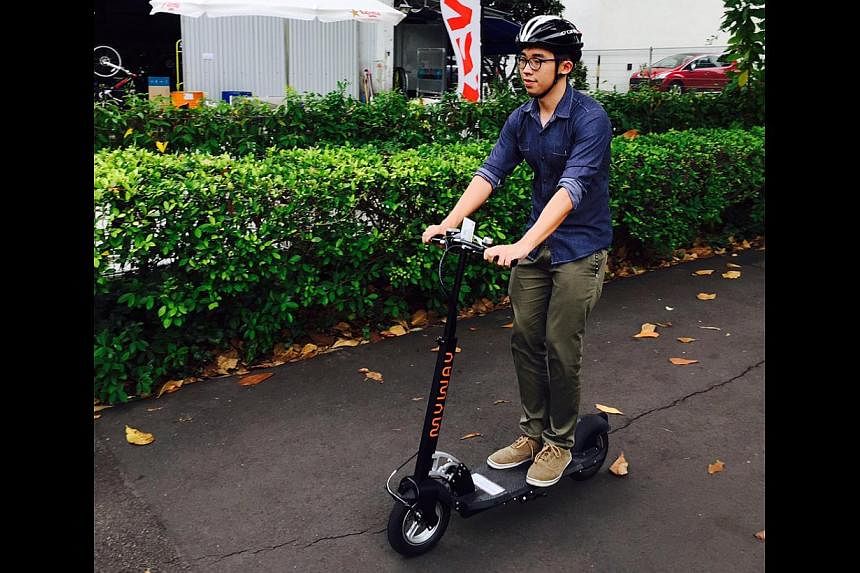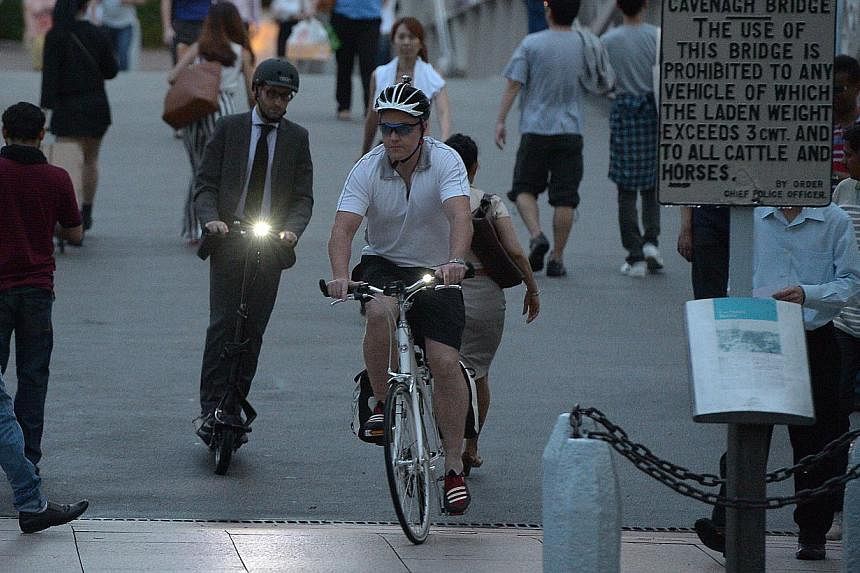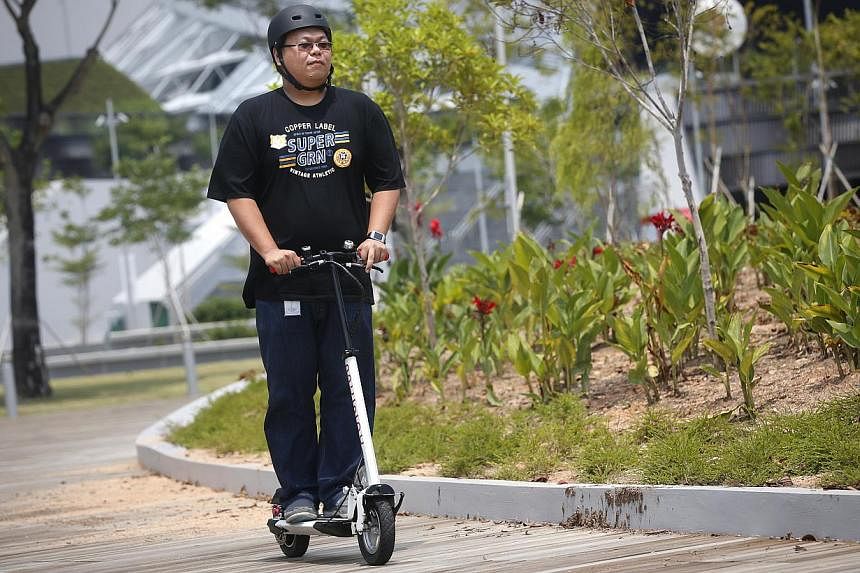Case manager Jeremy Kok, 29, recalls a time when he would zip from his home in Geylang to his Chai Chee workplace, then to evening class in Somerset and back home on his electric kick scooter.
His daily 36km journey plied a scenic route past landmarks such as the Esplanade, Gardens by the Bay and Marina Barrage.
On weekends, he and his girlfriend would scoot to the nearby Kallang Wave Mall to shop and dine.
Says Mr Kok: "I've cut down my trips to two or three times a week now. There has been too much unwanted attention lately."
Electric kick scooters and other personal transport vehicles such as the Segway are not allowed on public roads and pavements, as well as parks and park connectors, a fact that has come under closer scrutiny recently.
Last week, The Straits Times reported that more people are riding their electric bicycles and scooters along park connectors, using them as speedy shortcuts and irking some pedestrians.
In the past month, at least two writers to the Straits Times Forum page have expressed alarm at the proliferation of these vehicles. One of them, Mr Chan Yeow Chuan, said he has noticed many users of electric kick scooters and bicycles speeding along pavements near his home in Sembawang.
According to the Land Transport Authority, those who use unauthorised vehicles on roads are liable on conviction of up to a $2,000 fine, or up to a three- month jail term for the first offence.
Those who ride on pavements and hurt pedestrians may be jailed up to a year or fined $5,000 or both, says the Traffic Police, while the National Parks Board (NParks) can levy up to a $5,000 fine on visitors using such vehicles at its parks and park connectors.
These vehicles, which have speeds of 20 to 40kmh, can be operated on private property with the owner's permission.
Replying to queries from SundayLife!, the Traffic Police says: "Singapore's footways are not wide enough for shared purposes. Given personal electric vehicles' construction and their ability to move at higher speeds, the risk of collision resulting in serious injuries to the users as well as pedestrians is significant."
NParks says it has put up more banners to remind visitors that such vehicles are not permitted in parks and that it would step up patrols against errant users.
The authorities are not able to provide figures of accidents and fines meted out so far, but no major accident involving such scooters has been reported.
Even as pedestrians and other road users call for stricter enforcement, a growing number of scooting converts are calling for these rules to be relaxed.
Many of them are from the Big Wheel Scooters Singapore Facebook group, the largest community of scooter users in Singapore. It has more than 3,100 members, up from 300 in November last year when it started, says founder Swen Einhaus, 40, an engineer from Germany. The Singapore permanent resident has also uploaded guidelines for safe riding in public places for members, such as wearing safety gear and dismounting to give way to pedestrians.
He says: "We enforce these rules during our outings. It's as much as we can do for now."
The group has yet to engage the authorities formally but is "looking at how to do so", he adds.
Mr Jeremy Tan, 24, a member of the group, says: "I think what the majority of e-scooter riders want is regulation in place of a ban." The entrepreneur rides his scooter regularly to run errands and meet his friends.
Users of these electric scooters and bicycles appreciate the convenience. For example, the scooters are ideal for completing the "first- or last-mile" journeys between one's home or workplace and transport nodes such as MRT stations as they are fast, reliable and portable.
Operations manager Jerick Herrera, 27, hops onto his foldable electric scooter to travel every morning from his Sengkang home to Sengkang MRT station. After alighting at Tai Seng MRT station, he unfolds his personal vehicle and scoots to office. This way, he saves up to two hours in his daily commute, he says.
"My main purpose is to bypass bus rides because the bus takes a while to come and even when it does, it's very crowded and sometimes I can't get on it. Scooting is more comfortable too," he explains.
Powered by chargeable batteries, electric scooters are also more energy-efficient than cars or motorcycles. For instance, a five-hour charge on the MyWay, a popular brand here, can cover up to 30km.
The relative affordability of the scooters is another selling point.
Mr Kok, who scrapped his ageing car in February and bought a GoBoard e-scooter for $1,200, estimates he has saved more than $1,000 a month in car instalments, insurance and petrol.
The trend looks set to stay as sales of scooters, which are priced from $680 to $2,000, have surged since they first appeared late last year, say retailers and distributors. Pricier models with higher speeds of up to 45kmh can be imported as well.
Falcon Portable Electric Vehicles, a major distributor here, has moved close to 800 units in the past 10 months, says its managing director, Mr Warren Chew, 38. His firm sells three brands of electric scooters, with the fastest model going up to 25kmh. It also provides safety briefings and encourages users to wear helmets.
"We see this as a product that can meet the Government's push for people to work, live and play closer to home. The only issue now is regulation, but we foresee that demand will grow as it is relatively affordable and easy to use," says Mr Chew.
But other road users are not convinced there is room for all.
Engineer Christina Cheong, 26, who has seen scooter riders whizzing past her while she is walking home in Yishun, says: "I've seen some people going so fast, they would definitely not be able to brake in time if someone dashed out."
Professor Lee Der Horng, a transport researcher from the National University of Singapore's civil and environmental engineering department, says: "There's simply no space for such vehicles on our roads and pavements, not to mention the potential safety threat that they pose."
He cites the cases of Shanghai and Beijing, where electric scooter users swarm the streets and weave through traffic, adding to the chaos. "They make it harder to plan and predict traffic flow," he adds.
To control the flow of such vehicles, the authorities must regulate aspects such as safety standards and speed limits, says transport economist Michael Li from Nanyang Technological University's Nanyang Business School. He specialises in urban congestion.
He suggests: "One way is to conduct trials in less crowded neighbourhoods, sort out any conflicts with vehicles and pedestrians first, gain the support of the community, then maybe take them to other areas."
For now, scooter users such as Mr Kok ride at their own risk. "It's a pity because scooting is so convenient, but I guess I will lie low till things change," he says.
BREEZY RIDE
The first sensation I get when I hop onto the electric kick scooter for the first time is the rush of speed.
With a slight kick and the gentle flip of a switch, I was off, gliding past joggers and sometimes even cyclists, the wind whipping my face. On my borrowed $2,000 MyWay e-scooter, which zips along at about 25km an hour, I easily keep pace with them.
Compared to its more expensive cousin, the Segway, which retails here for $13,800 and up, the electric scooter throttles more smoothly, although it does not manoeuvre as well.
Slopes are manageable, but narrow twists and turns prove too daunting. I wobble, then sheepishly dismount to navigate them, although my handler assures me that "it's possible to turn, just takes a bit of practice".
And while scooting comes with its thrills, you may well take a spill too, especially given how crowded our parks and pavements can get.
Even on a quiet Tuesday afternoon, I have to brake for or circle around pedestrians thrice during a 10-minute trial at a park connector near Balestier.
I have to slow to a crawl when an alarmed woman yanks her dog out of the way upon spotting me barrelling towards them.
It is easy to see why this speedy gizmo has won many hearts here, though. It is easy to ride (all you need to do is kick off and maintain your balance) and efficient (a five-hour charge of its lithium-ion battery can cover up to 30km).
Better yet, you arrive at your destination sweat-free - a feat in our sunny island.
The convenience is what keeps users, such as a 29-year-old expatriate trader who wants to be known only as Mr Yuki, scooting despite the ban on such vehicles in public areas here.
He says: "I save 40 minutes and up to $30 in cab fares a day and it doesn't pollute the roads."
But is one's convenience worth the safety of others? While there have been no reports of major accidents involving e-scooters, pedestrians have cited near-misses. Worse things could happen as these scooters proliferate islandwide.
Lee Jian Xuan




